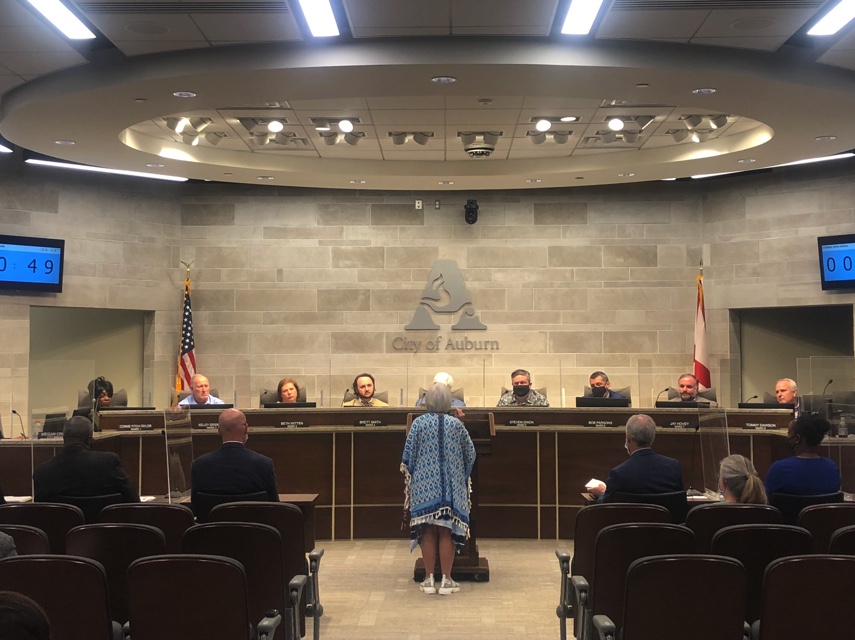BY HANNAH LESTER
HLESTER@OPELIKA
OBSERVER.COM
Recently, the Census data was released which showed the growth in the city of Auburn. The population grew by more than 22,000, with more than 1,500 acres added to the city.
Auburn’s total population is 76,143 and the goal is for each district to have about 9,518. In 2010, Auburn’s population was 53,380 with each district ideally having about 6,672 residents.
“Redistricting occurs after each decennial census so that political representation reflects population growth and change,” the city of Auburn website said. “The Code of Alabama 1975, Section 11-43A-33 sets forth redistricting procedures that include a process where the City must review and, if needed, redraw the district (ward) boundaries based on the 2020 census population with the purpose of gaining equal representation for each district by having as nearly as possible equal population in each.”
Redistricting must be completed within a set time frame. It occurs six months after receiving Census data and six months before the next municipal election, which for Auburn is on Aug. 23, 2022.
Redrawing city lines to hopefully reach the population goal of 9,518 residents per ward has to be within 5%.
“In addition to achieving population equality, redistricting plans must comply with Section 2 of the Voting Rights Act,” the city site said. “Often, this means drawing one or more minority-majority districts, depending on the size of a jurisdiction’s minority population. Ward 1 is 46.6 percent Black by total population, and 44 percent Black by voting age population. This is the largest demographic group in the ward. The next largest demographic is white with 39.0 percent of total population. As such, Ward 1 performs reliably as a majority-Black district.”
The local branch of the NAACP, branch #5038, approached the city of Auburn on Dec. 7 with a redistricting plan that would include a second minority-majority district.
The local branch hired cartographer Tabitha Isner from Montgomer, as part of the process of looking at redistricting.
Auburn’s minority population has grown to 36.8% of the total population, said Laticia Khalif, vice president of the local NAACP branch.
“We need at least two council members to be representative of a non-white, racial, minority group,” she said. “Given that Auburn now has a significant black population, a significant Hispanic population and a significant Hispanic and Asian population, so I’m just asking you look around.”
However, Ward 6 Council Member Bob Parsons reminded the council that while it may not look like it on first glance, he is representative of a minority group. Which means he is the second council member, including Ward 1 Council Member Connie Fitch-Taylor, that is representative of a minority group.
The group provided maps to the city of Auburn outlining where a second majority-minority district could be located.
“We’re not saying this map is perfect, we’re not saying you need to vote on this map,” said one citizen, Elizabeth Hill. “We’re saying that we have proof of concept that two majority-minority districts can be drawn in this city. And we think that more fairly represents what this city is comprised of, now, in 2020.”
With this plan in mind, representatives of the branch asked the council to postpone its vote on approving the maps the city has, which are available here: https://2021-redistricting-plan-coa.hub.arcgis.com.
The vote is set to take place on Dec. 21.
“We are asking you to slow this process down, meet with us and let’s discuss a new map,” Khalif said. “Can it be done, can we get two minority-majority districts? Absolutely.”
Following the several community members, civic groups and NAACP members who spoke, City Manager Megan Crouch spoke and let everyone know that the Auburn council did not propose the city’s maps.
“A map was proposed by state law by the city manager,” Crouch said. “The city manager used a team of experts on her staff to generate that map with only federal criteria we were asked to utilize and that is what we followed, period. We don’t get to insert our opinions, we don’t get to look at demographic data differently, we can’t look at how many students are here or there or whatever. We have to purely follow the criteria and that’s what the staff did.”
The council does vote to approve the map, however.
There will be a public hearing with the Dec. 21 meeting.


